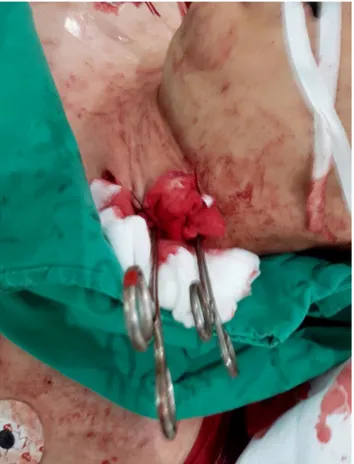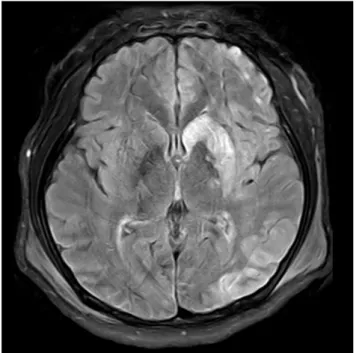Received: September 7, 2017 Revised: December 7, 2017 Accepted: December 7, 2017 TRAUMA AND INJURY
Correspondence to Hongjin Shim, M.D.
Trauma and Surgical Critical Care, Depart- ment of Surgery, Yonsei University College of Medicine, 20 Ilsan-ro, Wonju 26426, Korea
Tel: +82-33-741-0990 Fax: +82-33-741-0574 E-mail: simong3@yonsei.ac.kr
http://www.jtraumainj.org Copyright © 2017 The Korean Society of Trauma
Common Carotid Artery Laceration Managed by Clamping at Emergency Department
Young Un Choi, M.D.
1, Kwangmin Kim, M.D.
2, Seongyup Kim, M.D.
2, Keumseok Bae, M.D.
2, Ji Young Jang, M.D.
2, Pil Young Jung, M.D.
2, Hongjin Shim, M.D.
2, Ki Youn Kwon, M.D.
31
Department of Surgery, Yonsei University College of Medicine, Seoul, Korea
2
Department of Surgery, Yonsei University Wonju College of Medicine, Wonju, Korea
3
Department of Orthopedic Surgery, Yonsei University Wonju College of Medicine, Wonju, Korea
Common carotid artery laceration is a life-threatening injury by causing hypovolemic shock. Nevertheless the initial management is very difficult until definitive surgery at operation room. Before neck exploration at operation room, arterial bleeding control by compressing the bleeding point is not always effective. We experienced one case with externally penetrating injuries in zone II neck, which was operated after clamping of common carotid artery in the emergency department. Here we report this case.
Keywords: Common carotid artery; Laceration
INTRODUCTION
Common carotid laceration is lethal and hard to control. Even more that, neck lacer- ation of Zone II is very hard to approach in emergency department (ED). If the con- dition of patient is in hypovolemic shock by massive bleeding, it makes worse causing coagulopathy with hypothermia and acidosis [1]. In this situation, bleeding control and patient management are very hard.
We report the case that common carotid artery laceration with cardiac arrest man- aged by clamping at ED.
CASE REPORT
A 25-year-old man presented with hypovolemic shock after being stabbed in the left
neck with a knife. The manual compression to injury site was applied until he was transported to trauma center. In- terval time from accident to ED was 17 minutes, but the bleeding from injury site was severe. Even though pushing the injury site, there was cardiac arrest due to hypovole- mic shock and manual cardiac massage was applied on
arrival. At the same time, neck exploration was done in ED.
Oblique skin incision along the anterior margin of left sternocleidomastoid muscle was applied and left common carotid artery was exposed. The left common carotid ar- tery was cut 70% circumferentially and severe bleeding was controlled by clamping the proximal and distal site and then return of spontaneous circulation was accom- plished (Fig. 1).
Then, the patient was sent to operation room. There were common carotid artery laceration and complete rupture of the left vagus nerve. The internal jugular vein was intact. Laceration site was repaired with prolene 6-0 continuous suturing and neurorrhaphy were performed (Fig. 2). The time interval from injury to reperfusion was 40 minutes.
We supplied eight packs of red blood cell (RBC) (2,000 mL), five packs of fresh frozen plasma (805 mL) and crys- talloid (normal saline, 5,000 mL) at the ED and two packs of RBC and crystalloid (Hartmann’s solution, 2,450 mL) at operation room.
After operation, the patient was moved to the trauma intensive care unit with intubated status and vital signs became stable. But mental status was coma and therapeu- tic hypothermia (<33˚C) after cardiac arrest was applied for 2 days. After 48 hours, brain computed tomography (CT) with angiography scan showed c (Fig. 3). The pa- tient showed right hemiplegia.
Therapeutic hypothermia and sedative drugs were stopped. On postoperative day (POD) 3, the patient’s mentality changed to drowsy and it changed to alert in
Fig. 2. Repaired common carotid artery and vagus nerve.
Lt. jugular vein
Vagus nerve Common carotid artery
Fig. 1. Clamped common carotid artery at the emergency department.
the next day. Brain magnetic resonance imaging scan on POD 4 showed same pattern with CT (Fig. 4). The patient
was transferred to general ward on POD 9 and transferred to rehabilitation department on POD 18 for comprehen- sive rehabilitation including gait training, speech therapy and dysphagia management. On manual muscle test, right hemiplegia got better 12 days later from transferring.
Shoulder, elbow and forearm, wrist, hip, knee and ankle level changed from zero to good or fair.
On POD 45, follow-up carotid ultra sonography showed 50% stenosis and flow limitation (peak systolic velosity 216.2 cm/s) on anastomosis site which is not indi- cated for intervention and no new or worsening of neuro- logic deficit occurred.
DISCUSSION
Major vascular injuries in the neck are frequently orig- inated from penetrating trauma. Carotid artery injuries occur in about 17% of patients with penetrating neck trauma and the survival rate of penetrating carotid in- juries is very low due to active arterial bleeding [2]. As it supplies major circulation for brain, the injury of carotid artery can induce a brain ischemia even though a small circulation of vertebral artery.
Fig. 3. (A) Brain CT with angiography scan: diffuse low density along the left cerebral hemisphere in is seen and indicator shows the low density
along the left basal ganglia and left head of caudate nucleus with suspicious high density along the caudate nucleus. (B) Brain CT, followed with (A).
CT: computed tomography.
A B
Fig. 4. Brain magnetic resonance imaging scan on postoperative day

